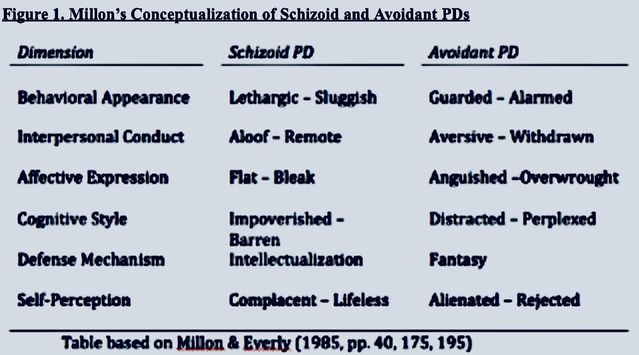Personality
Solitary Psychopathology: Millon’s Trait Model
Understanding subtypes of the detached personality.
Posted November 1, 2019 Reviewed by Devon Frye
Millon applied a comprehensive integrative-systems perspective (i.e., a conception of personality as characteristic patterns of behavioral and interpersonal action, affective experience and expression, and ideation) to the classification of PDs in DSM-III and labeled it the biosocial learning approach (Millon & Everly, 1985, p. 27). It generated a model of personality classification based on the notion of individual differences in reinforcement strategies, with a focus on (a) the way in which an individual looks for reinforcement or reward/pleasure (i.e., either actively/pro-active or passively/re-active) and (b) the location/object of the individual’s pursuit of reinforcement (i.e., in others or in oneself) (Millon & Everly, 1985; see Livesley et al., 1985, for a review).
Using this theory, Millon categorized personality into eight groups or personality types. The detached type (i.e., either active or passive and does not seek pleasure/reward from self or others) included the (a) "inhibited personality pattern," defined as active-detached and (b) the "introverted personality pattern," defined as passive-detached (Millon & Everly, 1985, p. 33). Consistent with the general principle that psychopathology exists on a continuum, Millon conceptualized PDs as pathological variants of these normal personality types.
Therefore, schizoid and avoidant PDs represented pathological versions of the two normal personality types, namely the two different detached personality subtypes (Millon & Everly, 1985). Millon and Everly defined detachment-based PDs as a class of dismissive, isolated, and introverted individuals with difficulties initiating and maintaining social connections and relationships and who are generally characterized by social avoidance and interpersonal discomfort (Millon & Everly, 1985, p. 171). Millon’s theoretical model of PDs postulated that this detached personality category contained two types of detached PDs: (a) schizoid PD, marked by passive-detachment and (b) avoidant PD, marked by active-detachment (Millon & Everly, 1985).

Consistent with DSM Axis-II (to be described further below), Millon and Everly viewed the cause of the observed social isolation and withdrawal as differentiating these two disorders, with schizoid individuals displaying impaired social-relatedness and isolation in the context of emotional and cognitive limitations, and avoidant individuals consciously driven to isolate to defend against potential shame, embarrassment, and rejection (p. 171 - 172; for a review, also see Miller et al. 2001).
Consistent with his integrated systems view of personality, Millon and Everly emphasized the importance of examining (a) defense mechanisms, (b) self-perception, (c) affective expression, (c) cognitive style, (d) interpersonal conduct, and (e) behavioral appearance for conceptualizing, classifying, and differentiating personality and PD types (Millon & Everly, 1985, p. 32).
Millon conceptualized these characteristics as trait dimensions, indicating a broader concept of personality trait as compared to factor analytic theorists (cf. Livesley, 2005; Widiger & Simonsen 2005). Millon (1981, 1985) also placed a strong importance on differentiating PDs according to their level of severity or dysfunction (also see Bornstein, 2006 for a similar view) for the diagnosis and classification PDs. Both schizoid PD and avoidant PD were conceptualized as equal in level of severity (i.e., both were classified as mildly-severe PDs) in this framework (Millon & Everly, 1985; Millon et al., 2004).
As shown in Table 1, Millon identified and distinguished between the core characteristics/trait-dimensions of schizoid and avoidant PDs. According to this classification approach, Millon conceptualized schizoid and avoidant PDs as distinct syndromes, characterized by a unique pattern of broadly conceived trait-dimensions from which the two syndromes can be differentiated.

Millon and Everly (1985) described the core underlying difference between schizoid and avoidant PDs as conflict in connection to the desire for social engagement and fear of rejection in avoidant PD as compared to the presence of social-cognitive and affective limitations in schizoid individuals.
In sum, Millon viewed schizoid and avoidant PDs as distinct and easily differentiable on a number of dimensions despite their shared detachment, a perspective which addresses more than just overt behavior and corresponding narrowly defined personality traits but also highlights underlying motivational, affective, and defensive processes as inextricably linked with the concept of personality and PDs. Thus, in this respect, Millon’s perspective parallels the psychodynamic view.
References
Millon, T. & Martinez, A. (1995). Avoidant personality disorder. In J.W. Livesley (Ed.), The
DSM-IV personality disorders. New York: Guilford Press.
Millon, T. (1981) Disorders of personality: DSM-III, Axis, II. New York: Wiley Interscience
Millon, T. & Everyl, G.S. Jr. (1985). Personality and its disorders: A biosocial learning
approach. New York: John Wiley & Sons.
Millon, T. (1986). Schizoid and avoidant personality disorders in DSM-III. American Journal of Psychiatry, 143 (10), 1321-1322.
Millon, T., Millon, C.M., Grossman, S., Meag, S., & Ramnath, R. (2004). Personality disorders
in moderns life. New Jersey: John Wiley & Sons.


